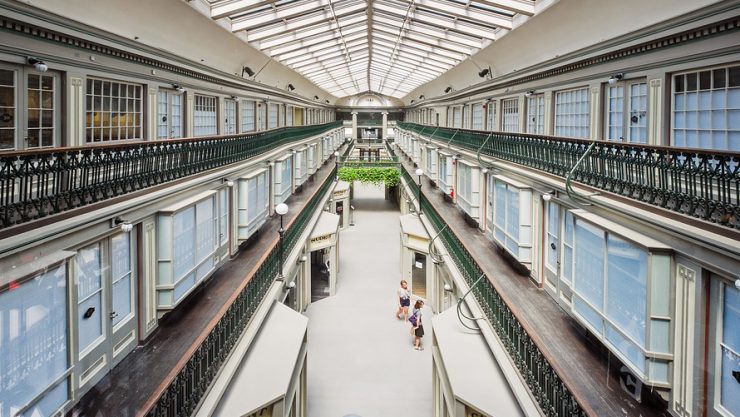Originally Posted by Daniel Goldstein
For Robin Dionne, director of outreach for the Arcade in Providence, R.I., expectations for the micro-apartment complex located in a repurposed shopping passage were initially as modest as the 225-square-foot dwellings she began hawking in 2014. “We had doubts that anybody would show,” she said.
But it turned out that small (most of the one-bedroom units are about the size of a hotel room) was just what some people had been waiting for. Now she has thousands of people on a waiting list for the tiny apartments. And it’s not just broke students looking for a cheap place to rent. “We have everybody from graduate students to people who are winding down toward retirement,” she said.
The Arcade, a historic three-story Greek Revival building that helps anchor downtown Providence, began life as effectively the nation’s first indoor shopping mall in 1828. Eventually, though, the Arcade — even having been designated a National Historic Landmark in 1976 — fell on hard times.
In 2013, owner Evan Granoff repurposed the top two floors of the Arcade into 48 so-called micro lofts, with one-bedroom or studio units, with retail on the ground floor. Rents at the Arcade start at about $850 for the studios, in line, according to Rent.com, with the $750 to $900 for a similar studio apartment elsewhere in the city, home to Brown University, Providence College and the Rhode Island School of Design, as well as the state capital.
Living in a micro loft is a lot like staying in a hotel room: You don’t need furniture (in the case of the Arcade, it’s all built in). There aren’t any stoves, although a microwave, a dishwasher and a fridge are included. No pets are allowed, and tenants have to pay for their own Wi-Fi. Laundry, for most renters, is down the hall.
Amenities include a secure 24-hour tenant lounge and common space, and Dionne said the Arcade actively focuses its marketing on the living space that lies beyond the apartment walls. The first floor of the Arcade includes retail space, with coffee shops and restaurants frequented by millennial tenants, as well as traditional amenities such as dry cleaners and hair salons. “The city itself is the living room,” said Dionne. “It’s really for busy people on the go who move here for work, or graduate school, or to explore.”

Photo by Justin Earsing
Many historical details remain intact at the Arcade, despite the structure’s reimagining.
Chuck Reed, an attorney with the law firm of Hopkins & Carley in San Jose, Calif., who served as mayor of that Silicon Valley city from 2007 to 2015, said he thinks micro apartments aren’t just for millennials but can be marketed to seniors and low-income residents as well. “I think it’s a way to bring the costs of a project down, which helps fund more affordable housing,” said Reed. “We’ll see more and more of it.”
Mary Hutchison, a real estate agent with Better Homes and Gardens Real Estate in Kansas City, Mo., added that her empty-nester and baby boomer clients are looking for apartments like the Arcade that may be small but are centrally located. “They are looking for something where they can walk everywhere,” she said.
In Washington, D.C., west of the Capitol dome, hotelier Aaron Katz is taking Arcade’s micro-loft concept a bit further with POD DC. While the POD hotel on H Street in the district’s burgeoning Chinatown Penn Quarter area looks like a conventional urban walk-up hotel, that’s where the similarities end. The 245 guest rooms will be about half the size of a typical hotel room, at just 150 square feet. Many include bunk beds, something unheard of in most hotel spaces. But Katz is banking on the belief that most POD guests after the hotel opens later this year won’t be spending much time in the rooms. They’ll be at rooftop lounge, or the bar or dining room or out on H Street itself.
“We feel the timing is right for D.C.,” he said.
And the POD hotel should not be confused with a youth hostel. Modus commissioned the New York design firm of Stonehill & Taylor to outfit POD rooms with high-end fittings, such as rain shower heads in the subway-tiled bathrooms, high-thread-count sheets and padded headboards with built-in LED reading lights. POD 39 New York includes a rooftop terrace and the restaurant Salvation Taco by Michelin-starred chef April Bloomfield.
Just down the street from the Watergate apartment and hotel complex, Modus and developer Jim Abdo are also repurposing a run-down tourist hotel as an 83-room micro hotel known as Hive.
As at POD, the rooms will be about half the size of a typical hotel room, and will rent for about $125 a night and will include a do-it-yourself pizza restaurant.
Not everybody is convinced of the staying power of the micro trend.
Kevin Finkel, senior vice president at Resource REI, a Philadelphia-based real estate investment trust that develops multifamily housing, called micro apartments a fad, saying only in places like Seattle or San Francisco, where land costs are tight and smaller spaces are more common, will this sort of living space truly catch on.
“Americans hate density. They want bigger cars, bigger houses, bigger meals,” Finkel said, adding that his company is actually investing in the renovation of older garden-style apartment complexes that have larger spaces because renters are demanding room for their pets. “We might have seen a bit of downsizing living-space-wise during the recession, but now that [the price of] gas is back down we’re going large again,” he said.
Andrew Carle, an adjunct professor at George Mason University in Fairfax, Va., who focuses on senior housing issues also sees the micro trend as a passing phenomenon. While attractive to millennials, he said, it’s unlikely to resonate with empty nesters over 65, who will represent one out of every five U.S. citizens by 2028.
“If you’re a twenty-something and you’re used to a dorm room, then 200 square feet is a lot of space,” Carle said. While some empty nesters like Hutchison’s clients may be thinking small, Carle is seeing the opposite in many cases. “Empty nesters aren’t downsizing; they’re upsizing. They’re adding rooms to their houses so their grandkids can visit.”
But the believers in the the small-is-big trend are not solely boutique players. Hotel giant Marriott MAR, +1.63% of Bethesda, Md., is opening a Moxy, a micro hotel built on the same concept as the Arcade in Providence along the D.C. power corridor of K Street, long dominated by the glittering names of the St. Regis, Crowne Plaza and the Mayflower. Marriott’s Moxy brand opened first in Europe in 2013, and U.S. properties have followed in Tempe, Ariz.; New Orleans; and Nashville, Tenn. Worldwide, Marriott plans nearly 60 Moxy locations.
The Washington. D.C., hotel at 12th and K streets is slated to break ground this year and open in 2017. The Moxy differs from POD in that it won’t have a restaurant attached, although a lounge and rooftop bar will be key to the model. “If you are in amazing urban locations you don’t need to impact your cost models with full-service restaurants,” said Vicki Poulos, director of the Moxy brand in the U.S.
Like POD and Arcade, the Moxy hotels will be small on room space but big on public space. “Smaller spaces in Europe have long been acceptable, and now it’s heading over to the U.S.,” Poulos said. “We want a communal, interactive environment where people are hanging out.”
To that end, you won’t find hotel employees behind a counter. “When you walk into a Moxy hotel, you’ll check in at the bar,” she said. “They’ll be making drinks and checking in customers.”
This article was originally posted on MarketWatch.com an can be found HERE.





